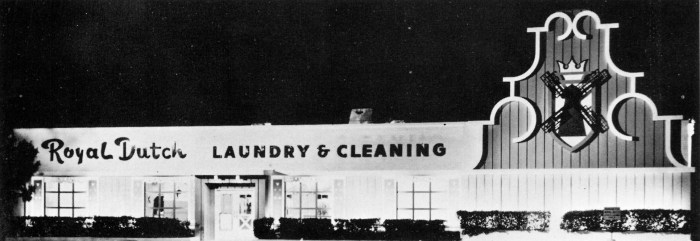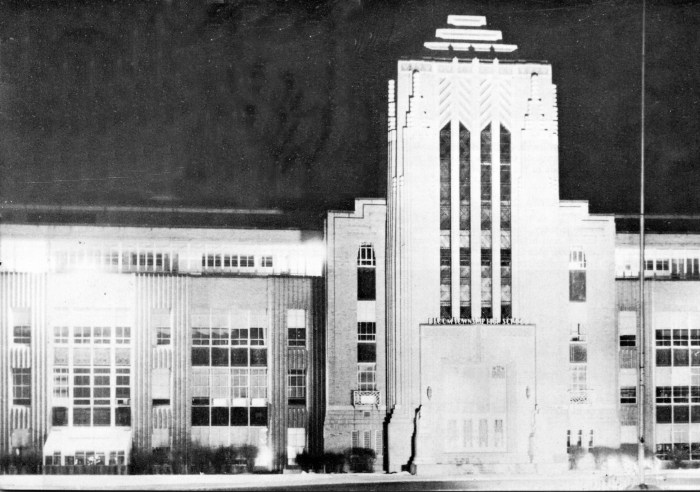It’s been a while since our last post re-printing the Mississippi Architect, a monthly magazine published by the Mississippi chapter of the American Institute of Architects. So let’s jump back in with the March 1964 issue.
As you may recall, the February 1964 issue contained an article documenting the “updating” of an Art Moderne commercial building by making it somewhat “Colonial.” An article in the March 1964 issue looks at the importance of outside lighting and the sociological impacts of increased night-time activity, and I thought it was interesting enough to include in addition to the first editorial by Edward F. Neal, of Jackson.
—————————————–
How Much Will Your Building Cost?
Every prospective building owner has to face the question of building costs, and the first person he should turn to for a reasonable answer is his architect. Until recent years the answers may have been evasive, casual, or overly optimistic, but fortunately there has been a swing in the right direction. Most architects who are properly trying to expand their services, now consider effective cost estimating to be a fundamental part of these services.
In the opening discussion stage of a building program, the architect may suggest probable building costs in terms of current area, volume, or other unit costs; but when preliminary drawings are submitted they should be accompanied by a semi-detailed estimate indicating proposed building materials and reflecting projected techniques in structure and in mechanical and electrical equipment. Finally, a revised estimate should be submitted after working plans and specifications are completed, in order to reflect changes made during the course of final plan development.
The question now becomes: Just how good is an estimate anyway?
It could be said that any estimate is better than none, but that would hardly be sufficient. Experience indicates that a five per cent variance between the low bid and the estimate is a desirable margin. Obviously we hope for better, but occasionally get worse, since the building industry seems subject periodically to radical ups and downs. The estimate of cost remains however an effective tool
which both architect and owner can use to keep their feet on the ground. One cannot expect to know exactly how much a building is going to cost, but he deserves an estimate from his architect which is sufficiently accurate to launch a successful building program.
Edward F. Neal
——————————————————–
Americans Are Becoming “NIGHT PEOPLE”
More Activity Concentrates in Evening Hours With Assistance of Modern Lighting

The people of Greenwich, Connecticut keep their Honor Roll Monument alive with floodlighting at night. The men who gave their lives are thus beautifully remembered and the meaning of this memorial is more apparent at night than during the day.
LITTLE less than two decades ago Americans did most of their shopping by daylight. It was common for Dad, Mom and the children to hustle off in the family car on Saturday for a day of shopping. For, with Dad at work and the children in school during the weekdays, virtually the only family shopping day was Saturday. However, the big, modern, well·lighted shopping centers which sprang up in the post· war period changed the shopping habits of the nation almost overnight. American shoppers became night people and latest statistics prove it.
Consider these facts, released by the Floodlighting Institute of Cleveland , Ohio, concerning recent studies of shopping centers:
- 31.4 per cent of the total traffic arrives during the three- to four-hour period after 6 PM
- Cars arriving at night carry 10 per cent more shoppers than those arriving during the day.
- The average night shopper spends 52 minutes in the center, compared with an average of 29.2 minutes for the daytime shopper.
The International Council of Shopping Centers of New York City conducted a survey of evening-hour
sales in shopping centers. A total of 245 centers responded as follows:
Percent of Reported percentage of
centers reporting gross volume after 6 P.M.
37.7 50 to 75%
36.7 30 to 50%
25.6 5 to 25%
100.0%

This Dallas, Texas laundry combines a distinctive architectural treatment and brilliant lighting to attract customers both day and night.
The change in buying habits has been a boon to the shopping center, but it has presented problems
for some of the long-established shopping areas, especially in small towns. Without positive action, these established merchants have found they could not compete with the shopping center in terms of shopper convenience.

Money is required to shop at night, just as in daytime, so bankers are also turning into "Night People." This is the Montclair Auto Bank Branch, National Newark and Essex Bank. Montclair, N.J.
In dozens of small towns and cities across the United States–and in some large ones, too–merchants have responded to the challenge. They bonded together into groups, bought property adjacent to their shopping areas, tore down existing buildings and turned the land into spacious, well-lighted parking areas. They also remodeled store fronts and interiors and relighted downtown streets.
This is one side of the coin. On the other side are the merchants and city officials who refuse to help themselves. They lament that business is suffering and land values have been reduced in downtown areas, but they refuse to take positive action to improve the situation.

The Epiphany Lutheran Church in Detroit, Michigan. Floodlighting at night suggests that it is prepared to answer the spiritual needs of the community.
People, given a choice, refuse to shop in poorly lighted areas, and the country’s constantly spiraling crime rate has a lot to do with it. With the threat of muggings, street attacks and robberies hanging over virtually every city, people generally avoid areas that do not provide proper lighting as some measure of protection.
The longer merchants and officials wait, the harder it becomes to revitalized affected business areas.

Floodlighting of school buildings reduces vandalism when buildings are not in use, encourages attendance when night activities are scheduled. This is Bloom Township High School, Chicago.
—————————————————–
This article is reprinted from the March 1964 issue of the Mississippi Architect, with permission from the Mississippi Chapter of the American Institute of Architects. View the full March 1964 issue of Mississippi Architect in a digitized format, or for other articles in this ongoing series, including the pdf version of each full issue, click on the MSArcht tab at the top of this page.
Categories: Architectural Research, Historic Preservation

Wonderful night photos!
The second to last paragraph makes me realize that things were not as safe back then as I like to think they were. The paragraph mentions “the country’s constantly spiraling crime rate” back in the 60’s? I was surprised to read that as my small town did not have a lighted shopping center in ’64. Our town was sort of like Mayberry RFD.
The article on building costs is great too! To date, we have not mastered the art of getting home upgrades done by anyone who will give us a written estimate. “Licensed” builder in Mississippi is the same phony baloney as the inspection sticker on your windshield. Is ethics part of the license? License seems to be just a way for the state to collect more fees.
LikeLike
Agree completely about “licensed.” I almost place more stock in “bonded and insured” nowadays!
LikeLike
Looking from a small-town, preservation – and National Park Service – perspective, I can clearly see that the waters have become a little more murky for downtown planning since 1964. Yes, we want to “save” downtown and promote the interest and usage to keep it thriving. But we also want to “save” what we can of the historic character of downtown – so demolition for well-lit parking lots is not always the answer, though a perception of adequate public parking is certainly one of the issues. Those large parking garages leading to streets converted to pedestrian malls didn’t seem to work for downtown Vicksburg. But the level of lighting is an important part of the historic character; and we need to be “saving” our energy usage as well. All of which calls for creativity and collaboration, and communication in our planning!
LikeLike
It would be interesting to do an article on the Mississippi towns with downtown “malls”–whether pedestrian only or some other attempt at diverting traffic–at one time in their life: Vicksburg, Greenville, Biloxi, (others?) and also those that had some attempt at “unifying” the downtown facades so that they kind of looked like shopping centers: Canton, Kosciusko, Amory, ?
LikeLike
I know that Amory still sports awnings over every storefront in their downtown from Vinegar Bend to City Hall, about three blocks. The awning, hideous though it may be, may be the reason Amory has such an intact downtown. Most of the buildings are merely one story, non-descript storefronts but there are no gaps in the awning or streetwall where there was once a building, unlike Meridian, Vicksburg, and a host of other cities that look like they are grinning gap-toothed grins due to the missing buildings. Aberdeen sports similar awnings and a few modern storefronts.
I doubt any Mississippi town can match the attempt in Haleyville, Alabama to modernize their downtown. Haleyville did not tear down their downtown (obviously good) but did something almost as drastic. Haleyville did not modernize the storefronts (most were modernized anyway), nor did the town make the downtown a pedestrian mall, nor did the town put up just an awning, but rather the town constructed a concrete structure to make the downtown an actual enclosed mall with holes in the middle every so often for light to stream in. If you every wondered what a quaint downtown would look like in a parking garage (since one could drive through it and park), Haleyville was your opportunity. The Haleyville Mall was demolished after damage from a 2001 tornado which literally plowed through the mall and downtown. I think the tornado just gave people in Haleyville an excuse to get rid of their mall/monstrosity, although the tornado destroyed much of what was around the mall.
LikeLike
Biloxi has something similar to that extreme, although I don’t believe it was completely enclosed. Maybe a Biloxian can remind us of the details of that downtown mall, but I think it was demolished in the late 1990s.
Pascagoula is another one that had some sort of mall-like structure, but more open, maybe a trellis or something above the street?
Now I definitely think this needs to be an article or series of posts, if only to remind ourselves of how some of these downtowns have come to be what they are today.
LikeLike
The Pascagoula downtown mall awning is completely gone with only some of the decorative supporting columns remaining.
Biloxi’s downtown mall has one awning pavilion remaining acting as a bus stop but it other wise is completely gone.
LikeLike
I’ve actually grown kind of fond of Amory’s awning. Some of its slipcovers look really early, maybe 1950s?
LikeLike
Aberdeen also has a couple of blocks of sidewalk awning. Not particularly pretty, but probably welcome on a Mississippi August afternoon.
LikeLike